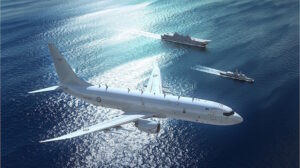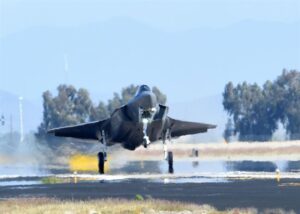Allies And The Maritime Domain Strike Enterprise
Posted on

Australian P-8
The UK, Norway and the US have signed an agreement to work together on anti-submarine warfare (ASW) in the North Atlantic which will leverage the joint acquisition of the P-8 aircraft, another example of the US and its allies an evolving defense capability in which allies are clearly key partners.
The P-8s is part of a cluster of software upgradeable airplanes which are defining the way ahead for combat airpower: the Australian Wedgetail, the global F-35, and the Advanced Hawkeye, all have the same dynamic modernization potential to which will be involved in all combat challenges of maritime operations.

Wedgetail
All military technology is relative to a reactive enemy. As my colleague Ed Timperlake has noted: “It is about the arsenal of democracy shifting from an industrial production line to a clean room and a computer lab as key shapers of competitive advantage.”
Much as allied F-35 pilots and maintainers are being trained initially in the United States and then standing up national capabilities, the same is happening with the P-8/Triton allies. The Brits and Australians are training at Jacksonville Navy, and this will certainly happen with the Norwegians as well. In fact, an RAF pilot has recently topped 1,000 flight hours on the P-8 at Jacksonville.
These allies cover key geographical territory, so shared domain knowledge and operational experience in the South Pacific and the North Atlantic is of obvious significance for US warfighting and deterrence. Given the relatively small size of the allied forces, they will push the multi-mission capabilities of the aircraft even further than the United States will do and, as they do so, the U.S. can take those lessons as well.
There is already a case in point. The Australians wanted the P-8 modified so they could do search and rescue — something that the US Navy did not build into its P-8s. Now that capability comes with the aircraft, something that was very much a requirement for the Norwegians as well. And the US Navy is finding this “add-on” as something of significance for the US.
I have visited the Australian and British bases where the P-8s and, in the case of the Aussies, the Triton is being stood up and talked with the Norwegians during my visit in February about their thinking with regard to the coming MDA enterprise. It is clear that they see an F-35-like working relationship as essential to shaping a common operational enterprise where shared data and decision making enhance the viability of the various nation’s defense and security efforts.
During my visit to RAAF Edinburgh, near Adelaide in South Australia where the Aussies will build their new submarines, I discussed the standup of the base and toured the facilities being built there. As with the F-35, new facilities need to be built to support a 21st century combat aircraft where data and decision-making tools are rich and embedded into the aircraft operations.
At the heart of the enterprise is a large facility where Triton and P-8 operators have separate spaces but are joined by a unified operations center. It is a walk-through area, which means that cross learning between the two platforms will be highlighted. This is especially important as the Aussies might well wish to modify the mission systems of two software upgradeable platforms to meet evolving Australian requirements.

First Norwegian F-35 touches down
Senior RAAF personnel highlighted the advantages of working with the US Navy and other partners from the ground up on the program. “In some ways, it is like having a two-nation F-35 program. Because we are a cooperative partner, we have a stake and say in the evolution of the aircraft. And this is particularly important because the aircraft is software upgradeable. This allows us working with the USN to drive the innovation of the aircraft and its systems going forward,” one of them told me. “We’ve been allowed to grow and develop our requirements collectively. We think this is very far sighted by the USN as well. I think we’ve got the ability to influence the USN, and the USN have had the ability to influence us in many of the ways that we do things.”
“We will be doing things differently going forward. It is an interactive learning process that we are setting up and it is foundational in character. We’re generating generation’s worth of relationship building, and networking between the communities. We are doing that over an extended period of time.”
“For about three years we have been embedding people within the US Navy’s organization. There are friendships that are being forged, and those relationships are going to take that growth path for collaboration forward for generations to come. When you can ring up the bloke that you did such and such with, have a conversation, and take the effort forward because of that connection. That is a not well recognized but significant benefit through the collaborative program that we’re working at the moment.”
“We are shaping integration from the ground up. And we are doing so with the Australian Defence Force overall.”
I visited RAF Lossiemouth as well where the Brits are standing up their P-8 base. With the sun setting on the Nimrod, the RAF has kept their skill sets alive by taking Nimrod operators and putting them onboard planes flying in NATO exercises, most notably the Joint Warrior exercises run from the UK. This has been a challenge to key skill sets alive with no airplane of your own, but the US and allied navies worked collectively as the bridge until the Brits get the new aircraft.
The base being built at Lossiemouth will house not only UK aircraft, but allow Norwegians to train and the US to operate as well. Indeed, what was clear from discussions at Lossie is that the infrastructure is being built from the ground up with broader considerations in mind, notably in effect building a 21st century MDA highway. The RAF is building capacity in its P-8 hangers for visiting aircraft such as the RAAF, the US Navy or the Norwegian Air Force to train and operate from Lossiemouth. In many ways, the thinking is similar to how building the F-35 enterprise out from the UK to Northern Europe is being shaped as well.
In effect, an MDA highway being built from Lossie and the F-35 reach from the UK to Northern Europe are about shaping common, convergent capabilities that will allow for expanded joint and combined operational capabilities. At this is not an add on, but built from the ground up.
Flying the same ISR/C2/strike aircraft, will pose a central challenge with regard to how best to share combat data in a fluid situation demanding timely and effective decision-making?
The UK is clearly a key player in shaping the way ahead on both the P-8 and F-35 enterprises, not just by investing in both platforms, but building the infrastructure and training a new generation of operators and maintainers as well. At the heart of this learning process are the solid working relationships among the professional military in working towards innovative concepts of operations. This is a work in progress that requires infrastructure, platforms, training and openness in shaping evolving working relationships.
Having visited Norway earlier this year and having discussed among other things, the coming of the P-8 and the F-35 in Norway, it is clear that what happens on the other side of the North Sea (i.e., the UK) is of keen interest to Norway. And the changes in Norway are also clearly of interest to the UK as it considers the reshaping of NATO defense capabilities in a dynamic region.
In my interview with the new Chief of Staff of the Norwegian Air Force, Maj. Gen. Tonje Skinnarland, she underscored how important the collaboration with partners and allies is as they operate new systems together.
Referring to the F-35, she argued that “With the UK, the US, the Danes and the Dutch operating the same combat aircraft, there are clear opportunities to shape new common operational capabilities… And with the P-8s operating from the UK, Iceland and Norway can shape a maritime domain awareness data capability which can inform our forces effectively as well but again, this requires work to share the data and to shape common concepts of operations.
“A key will be to exercise often and effectively together. To shape effective concepts of operations will require bringing the new equipment, and the people together to share experience and to shape a common way ahead.”
In effect, a Maritime Domain Awareness highway or belt is being constructed from the UK through to Norway. A key challenge will be to establish ways to share data and to enable rapid decision-making in a region where the Russians are modernizing their forces and expanding their reach into the Arctic.

Scan Eagle
Obviously, a crucial missing in action player in this scheme is Canada. In my discussions with Commonwealth members and Northern Europeans there is clear concern about disappearing Canadian capabilities.
Perhaps one way to generate a way to keep ASW skills alive while Canada works towards 21st century systems might be for Canada to join with the UK and Norway to procure a set of Tritons in common and work common data sharing arrangements. Perhaps a model to sell data rather than buy aircraft might be considered as well which has been the model whereby Scan Eagle has operated with the US Marines.
As the Norwegian Air Force COS put the challenge: “We should plug and play in terms of our new capabilities; but that will not happen by itself, by simply adding new equipment. It will be hard work.”
That will include the possibility of an expanded relationship with India as well. The Indians have purchased P-8s as well but have put unique systems on the aircraft to do many of the missions. There is an inherent potential for India to work with the other P-8 partners as well, but full cooperation will require reaching a number of data-sharing agreements with the other P-8 partners.
In effect, the P-8 will be part of the evolving naval collaborative framework between the Indians and the U.S. as well as with other allies. What makes the P-8 an especially interesting platform is that it is a shared platform between India and the U.S., with others, such as Australia, likely to join in and this sharing of a platform can provide a tool for enhancing collaboration in the daunting task of shaping effective ISR for 21st century maritime missions.
The opportunity is inherent in the technology. The challenge will be to shape the collaborative approach and shared concepts of operations. The threats they all face require nothing less.
Subscribe to our newsletter
Promotions, new products and sales. Directly to your inbox.
